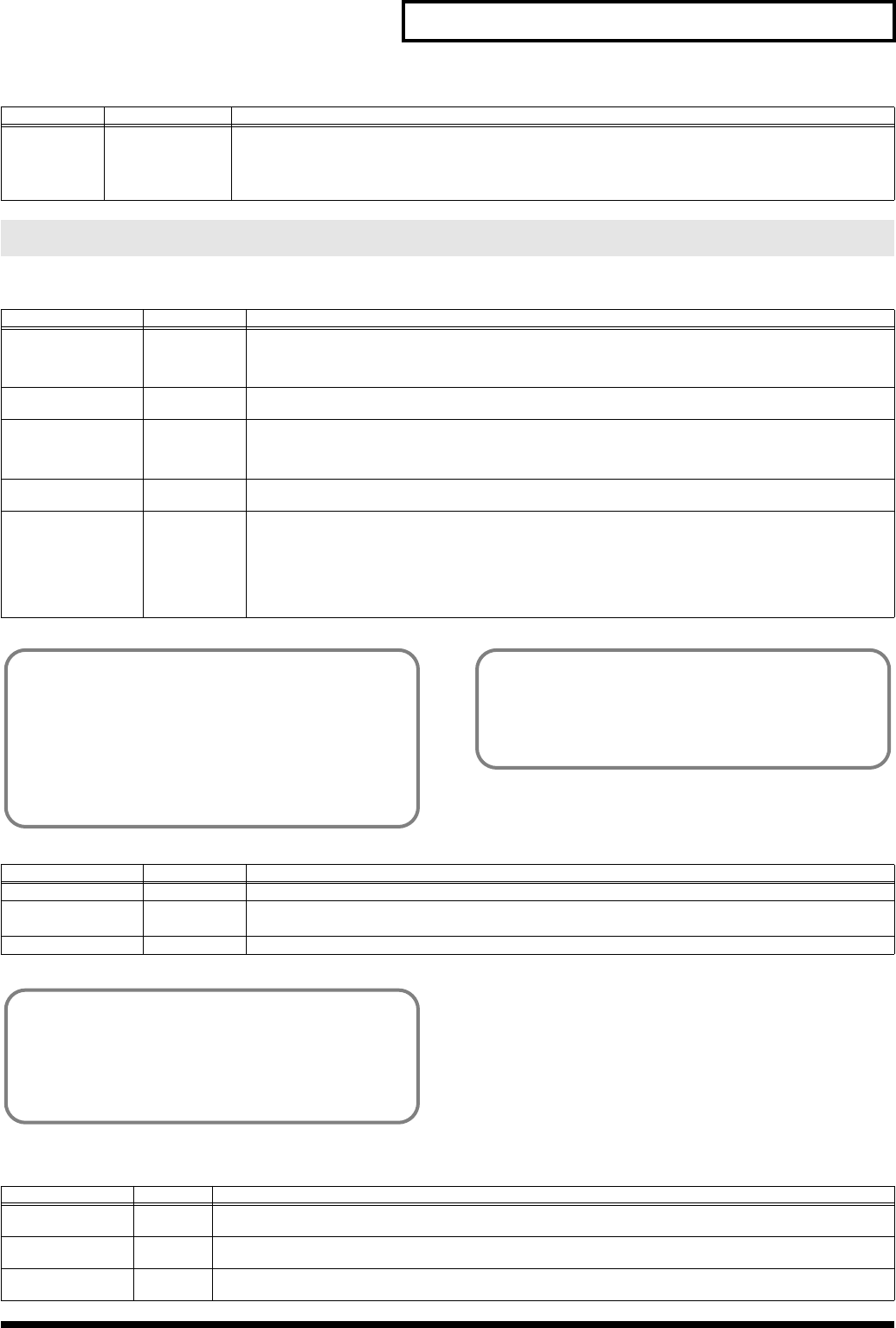
53
Creating a Rhythm Set
WAVE PARAMETER
WAVE PITCH
Tone Receive
Pan Mode
CONTINUOUS,
KEY-ON
For each rhythm tone, specify how pan messages will be received.
CONTINUOUS:
Whenever Pan messages are received, the stereo position of the tone will be changed.
KEY-ON:
The pan of the tone will be changed only when the next note is played. If a pan message is received while a
note is sounding, the panning will not change until the next key is pressed.
* The channels cannot be set so as not to receive Pan messages.
Modifying Waveforms/Pitch/Pitch Envelope
Parameter
Value Explanation
Wave Group
INT, EXP,
SAMP
Group containing the waveforms comprising the rhythm tone
INT:
Waveforms stored in internal
EXP:
Waveform stored in a Wave Expansion Board (SRX series) installed in EXP slots
SAMP:
Sample waveforms
Wave Bank PRST, USER,
CARD
When the Wave Group is SAMP: PRST, USER, CARD
When the Wave Group is MSAM: USER, CARD
Wave No. L (Mono)
Wave No. R
----, 1–1267 Waves comprising the rhythm tone (The upper limit will depend on the wave group.)
When in monaural mode, only the left side (L) is specified. When in stereo, the right side (R) is also specified.
If you want to select a left/right pair of Waves, select the left (L) Wave number, and then hold down [SHIFT] and
press [F4 (STEREO)] to add a check mark (
✔
); the right (R) (Wave) will be recalled.
Wave Gain -6, 0, +6, +12 Gain (amplification) of the waveform
The value changes in 6 dB (decibel) steps—an increase of 6 dB doubles the waveform’s gain.
Wave Tempo Sync OFF, ON When you wish to synchronize a Phrase Loop to the clock (tempo), set this to “ON.”
* This is valid only when a separately sold wave expansion board is installed, and a waveform that indicates a tempo (BPM) is
selected as the sample for a tone.
If a waveform from a wave expansion board is selected for the tone, turning the Wave Tempo Sync parameter “ON”
will cause pitch-related settings and FXM-related settings to be ignored.
• If a sample is selected for a tone, you must first set the BPM (tempo) parameter of the sample.
• If a sample is selected for a tone, Wave Tempo Sync will require twice the normal number of voices.
Parameter
Value Explanation
FXM Switch
OFF, ON This sets whether FXM will be used (ON) or not (OFF).
FXM Color 1–4 How FXM will perform frequency modulation
Higher settings result in a grainier sound, while lower settings result in a more metallic sound.
FXM Depth
0–16 Depth of the modulation produced by FXM
Parameter
Value Explanation
Tone Coarse Tune
0 (C -)–
127 (G9)
Pitch at which a rhythm tone sounds
Set the coarse tuning for Waves comprising the rhythm tones with the Wave Coarse Tune parameter (p. 54).
Tone Fine Tune -50– +50 Pitch of the rhythm tone’s sound (in 1-cent steps; one cent is 1/100th of a semitone)
Set the fine tuning for Waves comprising the rhythm tones with the Wave Fine Tune parameter (p. 54).
Tone Random Pitch
Depth
0–1200 Width of random pitch deviation that will occur each time a key is pressed (in 1-cent steps)
If you do not want the pitch to change randomly, set this to “0.”
Parameter
Value Explanation
Phrase Loop
Phrase loop refers to the repeated playback of a phrase that’s
been pulled out of a song (e.g., by using a sampler). One
technique involving the use of Phrase Loops is the excerpting of
a Phrase from a pre-existing song in a certain genre, for example
dance music, and then creating a new song with that Phrase
used as the basic motif. This is referred to as “Break Beats.”
Realtime Time Stretch
If the wave group is “SAMP” or “MSAM,” and the Wave
Tempo Sync parameter is turned “ON,” you can vary the
playback speed of the waveform without affecting the pitch.
FXM
FXM (Frequency Cross Modulation) uses a specified waveform
to apply frequency modulation to the currently selected
waveform, creating complex overtones. This is useful for
creating dramatic sounds or sound effects.
JUNO-G_e.book 53 ページ 2006年2月13日 月曜日 午後2時44分


















